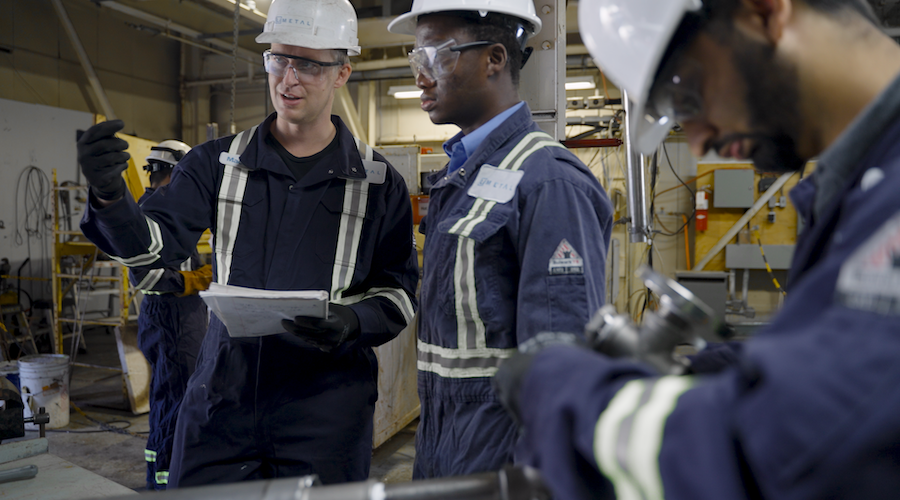Li-Metal’s technologies targeting next-gen battery market

Born in 2018 after a series of lunchtimes conversations on Toronto’s Bay Street between former Hatch engineers Maciej Jastrzebski and Tim Johnston, Li-Metal Corp. (CSE: LIM) is a company currently providing low-cost anodes to battery developers working on cells undergoing qualification trials for the coming generations of electric vehicles.
Building on this momentum, the firm is also taking steps towards building out capacity and producing its own lithium metal to become a reliable local supplier of critical materials.
“Li-Metal’s overarching strategy is to entrench then grow,” CEO Jastrzebski told MINING.COM.
Convinced that lithium metal batteries are the next big thing, the Canadian company developed a lithium metal production process that takes lithium carbonate, as recycled or virgin powder or granules, and dissolves it in molten salt. This is then electrolyzed in a membrane electrowinning cell which splits the lithium carbonate into technical-grade lithium metal and off-gas. The technical grade lithium metal is refined further to create high-performance, battery-grade metal.
According to Jastrzebski, this process is less expensive than existing lithium production processes, can utilize domestic chemical sources, and is more sustainable.
“Our lithium metal production uses a different feedstock; lithium carbonate, rather than lithium chloride, which is very advantageous. This requires a two-compartment cell with separate electrolytes for the cathode and anode, so the structure of the cell and operating philosophies are quite different compared to the conventional process,” the executive said. “The only similarity is that as the conventional process, it is a molten salt electrolysis process.”
MDC: What makes it more sustainable?
Jastrzebski: One of the biggest advantages of our process is that it avoids electrolyzing lithium chloride. When you electrolyze lithium chloride, you release about five tonnes of toxic chlorine gas for every tonne of metal you produce. This manifests as both fugitive emissions in the plant, and tail gas that has to be captured and treated. By eliminating this source of emissions, we are able to reduce the environmental impact of the process by-products. Similarly, because our process doesn’t require sophisticated gas-treatment equipment, we eliminate the energy and materials associated with its operation.
MDC: What makes it cheaper?
Jastrzebski: Firstly, most high-purity lithium chloride is made from lithium carbonate, so by using lithium carbonate directly we eliminate a conversion step that normally adds to the input cost of the feedstock. Secondly, because we don’t need to build and operate the same sophisticated gas treatment equipment, we save both on the initial build cost of the plant, and on the operating cost relative to the conventional process.
New anode technology
As it develops its lithium metal production technology, Li-Metal is also working on a new lithium anode technology.
The feedstock for both developments is obtained in the open market but once commercial-scale operations begin, the intention is to source sustainable, North American raw materials, including lithium carbonate from recycled batteries.
Jastrzebski said the company’s anode technology uses a roll-to-roll deposition process that consists of unwinding wide-format micron-scale material from the substrate roll and then passing the substrate through one or more deposition zones where lithium metal is applied together with a combination of other materials. From there, the completed anode is wound onto the product roll and packaged in argon gas for shipping, battery production or storage.
“The foundation behind our anode products is roll-to-roll physical vapour deposition – this is a technology that has been successfully applied in producing large format low-cost metallic products for decades,” the CEO said. “Our approach is unique because of the variety of materials we can deposit in a single pass. This gives us the capability to impart a variety of properties to the anode materials that can be used to enhance the electrochemical or economic performance of the materials.”
According to Jastrzebski, Li-Metal’s lithium anode technology uses less lithium for every square meter of anode compared to the alternatives available today.
“Existing lithium metal anodes are made by first extruding and rolling lithium into thin sheets. They can make thick foils that are between 40 and 150 microns but it becomes costly and difficult to scale as you approach the thicknesses that are needed for next-generation batteries,” he said. “Our technology does the opposite – it gets more economical as the anode thickness decreases and the cell size increases – which is exactly where next-generation batteries are going.”
MDC: What are Li-Metal’s plans once the patents for the anode technology and the lithium metal production process are approved?
Jastrzebski: We have a healthy technology and product development roadmap and we are continuously expanding our patent portfolio – we’ve filed additional patent applications this year, so we don’t really see patent approval as an end-state, but rather as part of our ongoing process.
We will also proliferate our technologies. We plan to supply and potentially license our anode production technology to battery and EV manufacturers, supply lithium metal consumables to operators of the technology, and continue to supply high-quality anode materials for high-performance batteries with pre-commercial and early commercial production runs to feed the pipeline.
Our key next steps are to commission our in-house advanced anode materials lab at our Markham, Ontario facility – we expect the work we have planned there to yield additional patentable IP. This will be shortly followed by the completion of our pilot roll-to-roll anode production facility in Rochester, New York where we will industrialize the research done in the anode lab. We are also anticipating the completion of our new lithium metal production pilot facility in Markham in the coming months. Looking further ahead, we are aiming to complete the engineering of our prototype commercial-scale anode production equipment and facility in 2022.
MDC: Where does Li-Metal fit in the next-generation battery supply chain?
Jastrzebski: Li-Metal can be thought of as a mid-stream supplier. Our value chain starts with bulk lithium carbonate and ends with rolls of high-performance metallic lithium anodes ready to go into battery cells. We are a customer of the chemical producers and a supplier to battery manufacturers. We can also potentially supply intermediate products such as metallic lithium to other industries.
The next-generation battery supply chain requires a completely evolved supply chain that doesn’t even exist yet. Producing next-generation batteries for electric vehicles with existing technologies can be costly, using more lithium than needed. Ultimately our technologies develop the building blocks for next-generation batteries creating more cost-effective, longer range, and safer electric vehicles.
More News
{{ commodity.name }}
{{ post.title }}
{{ post.date }}



Comments